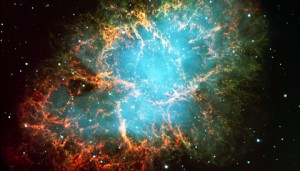A brief burst of radio waves, known as a fast radio burst, has been observed repeating, enabling astronomers to settle its exotic origin.

ESO
For nearly a decade, astronomers have strived to solve the puzzle of fast radio bursts (FRBs). Because these millisecond flashes of radio light appear extremely bright and yet very distant, astronomers suspect they could represent an entirely new class of astrophysical objects. So with every new FRB, they swivel their antennas toward the crime scene with the faint hope that a flash might appear again. But that hasn't happened — until now.
In November, 2012 a powerful burst washed over the Earth. Then two more bursts occurred on May 17, 2015, and eight more on June 2, 2015 — all came from the same patch of sky and the same distance. For the first time, astronomers observed a repeating FRB. The results, published March 3rd in Nature, suggest a rapidly spinning stellar core might explain this burst’s origin.
“The repeating FRB is a sensation — I would trade five of ours for it,” jokes Matthew Bailes (Swinburne University), who was not involved in this study. It’s possible that no one wanted to find a repeating burst more than him. With only one observation back in 2007 (when the first FRB was discovered) he had a nagging concern that it might not be astrophysical at all. “I remember I actually had trouble sleeping because I just couldn't believe that something could be this bright and yet that far away,” he says.
The fact that this FRB repeats assures Bailes that these odd signatures are in fact astrophysical. And to boot, it provides tantalizing hints about what might spark the explosion of radio waves. “It tells you without a doubt that this is not a cataclysmic event like a core-collapse supernova or a neutron star-neutron star merger because that kind of event destroys the object,” says coauthor Jason Hessels (Netherlands Institute for Radio Astronomy). “There's nothing left over afterwards that's going to produce another burst.”
Additional clues come from the bursts’ unusual character. For example, the bulk of its emission flip flops between higher and lower frequencies — behavior similar to that produced by the highly magnetized pulsar rapidly spinning at the heart of the Crab Nebula. So lead author Laura Spitler (Max Planck Institute for Radio Astronomy) speculates that this FRB might point to a more energetic class of pulsars visible beyond the Milky Way. Future observations could verify this idea if astronomers could pin down a regular period for these bursts.
But that idea stands in stark contrast with multiple scenarios that try to explain these mysterious bursts. It also contradicts an observational result published last week, where for the first time, astronomers were able to zero in on a fast radio burst’s host galaxy. Because it was an elliptical galaxy, well past its prime period for star formation, the find suggested that that FRB was likely caused when two aging stars coalesced.
Taken together, these two results could suggest that FRBs may have at least two origins: periodic outbursts of young stars that are likely closer to home and single outbursts of aging stars in the distant universe. Although Occam’s razor might suggest a single origin is at play, astronomers have multiple examples of, well, multiple origins. Take gamma-ray bursts which can originate from either two neutron stars as they merge together or the single collapse of a rapidly rotating star. The universe tends to be messier than Occam would like. Regardless, both results show tremendous strides after a decade of near radio silence.
“We're definitely getting to the point where we're seeing the fruits of our efforts in the sense that we're doing quick rapid follow-up and we're looking with more telescopes,” says Spitler. “But I wouldn't say that it's coming together in the sense that we're almost done. I really think that we're just getting started.”
Although future observations will continue to shed light on the mysterious origins of these bursts, one thing is certain: the bursts are truly astrophysical. And thanks to that, Bailes sleeps much better at night now.
Reference:
L. G. Spitler et al. “A Repeating Fast Radio Burst.”Nature. March 10, 2016.
 2
2
Comments
March 3, 2016 at 8:26 pm
Interesting phenomena. I wonder why the SETI project has not come across these radio bursts in their data?
You must be logged in to post a comment.
Phil-Perry
March 8, 2016 at 11:53 am
I'm sure SETI has seen them at some point. Some people have even speculated that they are evidence of alien intelligent life. It's quite possible, though, that their characteristics simply don't match what SETI is looking for in an artificially produced signal, and they are ignored as a natural phenomenon. Their very brief life and (until now) nonrepeatability may count against them.
You must be logged in to post a comment.
You must be logged in to post a comment.